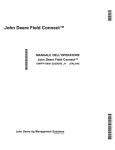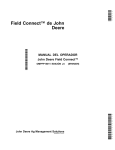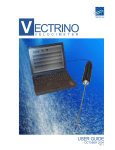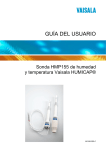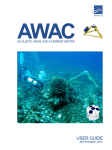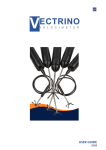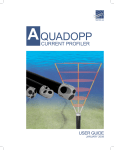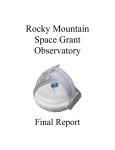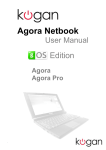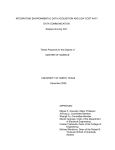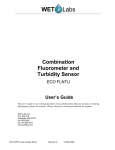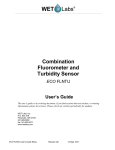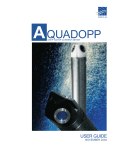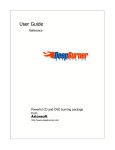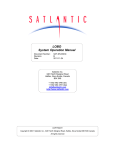Download MET-OCEAN STATION DRAFT USER MANUAL January
Transcript
MET-OCEAN STATION DRAFT USER MANUAL January 8, 2008 Evans Hamilton Inc. 3319 Maybank Highway Johns Island, South Carolina 29455 843-377-0286 843-377-0287 Fax [email protected] Liability Statement This system is a complex and sophisticated piece of oceanographic equipment. It should be used and maintained by qualified personnel familiar with its proper use and care. This system utilizes voltages and currents that could be dangerous if misused or damaged. As such, EVANS-HAMILTON, INC. and NORTEK USA waive and disclaim any liability risks associated with the use and maintenance of this system. EVANS-HAMILTON, INC. and NORTEK USA cannot control who operates or maintains this device nor can they control how it is used, other than in the original configuration as supplied, and for its intended purpose. Therefore, acceptance of this system by the customer shall be considered and deemed as agreement to hold EVANS-HAMILTON, INC. and NORTEK USA free of any liability claims associated with the use and maintenance of this system. The final accuracy of the data generated by this equipment is the sole responsibility of the customer. This system has been manufactured to demanding specifications and the sensors used are of the highest quality. EVANS-HAMILTON, INC. and NORTEK USA guarantee the quality and accuracy of the data generated by this equipment at the time of delivery to the customer. It is the customer’s responsibility to continually check and determine the quality of the data from this device throughout its service life, especially if it is used in an application where public safety is a concern. i TABLE OF CONTENTS Section Subject Page INTRODUCTION................................................................................... 1 2.0 COMPONENTS...................................................................................... 1 2.1 Electronics Box and MET Platform.................................................. 2.2 Datalogger............................................................................................ 2.3 Meteorological Sensors....................................................................... 2.3.1 Vaisala HUMICAP Humidity and Temperature Probes ............. 2.3.2 Vaisala Pressure Transmitter ...................................................... 2.3.3 Gill Wind Sonic Anemometer....................................................... 2.3.4 TE525 Tipping Bucket Rain Gauge ............................................. 2.4 Oceanographic Sensors ...................................................................... 2.4.1 Nortek Vector Current Meter....................................................... 2.4.2 WET Labs FLNTUS 796 .............................................................. 2.4.3 Paroscientific Pressure Sensor .................................................... 2.4.4 WET Labs WQM .......................................................................... 2.5 Power.................................................................................................... 2.6 Communication Hardware ................................................................ 1 1 2 2 2 2 2 2 2 2 3 3 3 3 3.0 INSTRUMENT INTEGRATION............................................................ 4 3.1 External Instrument Layout ............................................................... 3.2 Component Locations Inside the Electronics Box ............................ 4 5 4.0 OPERATIONS ....................................................................................... 6 4.1 System Installation.............................................................................. 4.2 Initiating Sampling ............................................................................. 6 7 5.0 DATA COLLECTION AND TRANSFER .......................................... 8 1.0 6.0 5.1 Data Collection .................................................................................... 5.2 Data Transfer ...................................................................................... 8 10 MAINTENANCE ................................................................................... 11 6.1 Servicing and Cleaning....................................................................... 11 ii LIST OF FIGURES Figure Title Page 1 External Instrument Layout .......................................................... 4 2 Component Locations Inside the Electronics Box........................ 5 APPENDICES APPENDIX I Campbell Scientific CR1000 Datalogger Manual APPENDIX II Program for Datalogger APPENDIX III Vaisala Humicap Manual APPENDIX IV Vaisala Pressure Transmitter Manual APPENDIX V Gill Wind Sonic Anemometer Manual APPENDIX VI TE525 Tipping Rain Bucket Manual APPENDIX VII Nortek Vector Manual APPENDIX VIII WET Labs FLNTUS 796 Manual APPENDIX IX Paroscientific Depth Sensor Manual APPENDIX X WET Labs WQM Manual APPENDIX XI Electrical System Components APPENDIX XII Airlink Cellular Modem Manual APPENDIX XIII Wiring Diagrams APPENDIX XIV Technical Data iii MET-OCEAN STATION 1.0 INTRODUCTION The Met-Ocean Station is provided as a collaborative effort between NortekUSA and Evans-Hamilton, Inc. (EHI). The Station includes sensors for measuring both meteorological and oceanographic parameters integrated with a data-logger and cellular link to shore. This manual provides documentation on the integration of the various components and overall operation. Detailed information on the operation of each of the components can be found in the individual manuals for each instrument, which are provided as appendices to this document. 2.0 COMPONENTS 2.1 Electronics Box and MET Platform. The electronics box is a watertight Integra polycarbonate enclosure measuring 18”X16”X10”. It is UV and impact resistant. The lid to the enclosure is secured by 4 stainless steel screws integrated into the lid. Within the enclosure are the battery, solar controller, surge protection system, barometric pressure sensor, the Campbell Scientific CR1000 datalogger, cellular modem, and pressure relief valve. Sensor wiring, antennae wiring, and grounding for the MET Station are all facilitated through either bulkhead connectors or water-tight cord grips on the rear and sides of the enclosure. Rubber dummy plugs are provided should a sensor and wiring need removal from the enclosure. 2.2 Datalogger The datalogger for this system is a Campbell Scientific CR1000. The datalogger has been programmed using CR Basic to monitor the different sensors and collect data at a specified time interval, log those data to the internal memory and then transmit the data via a cellular modem. The manual for the datalogger is provided in Appendix I. The program for the datalogger is provided in Appendix II. The datalogger has multiple analog signal inputs, a 1-GB memory card and 4 serial ports. The interface software for the datalogger is Campbell Scientific’s LoggerNet, which can be used to communicate with the datalogger, develop the datalogger data collection program in CR Basic, download data, check the system status, troubleshoot the datalogger and control the post processing routine. LoggerNet software can be used to communicate with the datalogger either directly through a serial port or remotely through a modem. To directly access the datalogger through the serial port, connect the computer to the unit with a DB9 232 connection on the front of the datalogger. Select “EZ setup” from the LoggerNet tab and click “Add”, then “Next”. Select the CR1000, leave the default name, and click “Next”. Click “Direct Connect” and “Next” and you will then be able to select your com port and baud rate to transfer data to and from the datalogger. An internet connection is required to connect to the datalogger remotely through the modem. To make the connection, open the LoggerNet software, and click on the “EZ MET-OCEAN STATION MANUAL setup” tab. There you will be guided through the process of setting the computer to call up the datalogger. For step-by-step instructions, see Section 5.2. LoggerNet can be used to manually connect to the datalogger on an as-needed basis or set up to automatically connect to the datalogger and download the data according to a fixed schedule. 2.3 Meteorological Sensors The meteorological sensors are connected to the datalogger. All of the sensors are powered via the datalogger’s 12-v power supply and report all of the data to the datalogger. No data are recorded to the internal memories of the sensors if present. 2.3.1 Vaisala HUMICAP Humidity and Temperature Probes These sensors measure relative humidity in percent and temperature and dew point in degrees C. The output is an analog signal. The manual for these sensors is provided in Appendix III 2.3.2 Vaisala Pressure Transmitter This sensor reports atmospheric pressure in millibars. The output is an analog signal. The manual for this sensor is provided in Appendix IV. 2.3.3 Gill Wind Sonic Anemometer This sensor is a sonic wind sensor that reports wind speed in knots and direction in degrees relative to north. The communication to this sensor is via RS-232. The wind sensor outputs data as an analog signal. The manual for this sensor is provided in Appendix V. See Appendix XIV for wind sensor settings. 2.3.4 TE525 Tipping Bucket Rain Gage This sensor measures the amount of rain fall in inches per hour. The output is an analog signal. The manual for this sensor is provided in Appendix VI. 2.4 Oceanographic Sensors Additional sensors are connected to the system that provide information on water level, velocity and quality. The data from these instruments go into the datalogger and are transferred to shore along with the meteorological data. All of these sensors communicate via RS-232 and the output is digital. 2.4.1 Nortek Vector Current Meter This instrument is a single point acoustic velocity sensor that measures current speed in cm/s and direction in degrees. It also measures water pressure and temperature and can take in 2 channels of analog data from external sensors. The manual for the Vector is provided in Appendix VII. See Appendix XIV for Vector settings. 2.4.2 WET Labs FLNTUS 796 The FLNTUS 796 is a combination fluorometer and turbidity meter that is connected to the Nortek Vector. The unit is powered through the Vector and measurements are recorded with the Vector data. This meter output counts which will need to be converted to engineering units by the user. The manual for the FLNTUS 796 is provided in Appendix VIII. 2 MET-OCEAN STATION MANUAL 2.4.3 Paroscientific Pressure Sensor This depth sensor utilizes DIGIQUARTZ® technology to report water level changes in bars. The manual for the Paroscientific (Paros) Pressure Sensor is provided in Appendix IX. See Appendix XIV for Paros settings. 2.4.4 WET Labs WQM The WET Labs WQM is a Wet Labs FLNTUS 796 with an integrated Sea Bird CTD. The system provides measurements of temperature, salinity, depth, dissolved oxygen, chlorophyll fluorescence and turbidity. This sensor connects directly into the datalogger. The manual for the WQM is provided in Appendix X. Note: This sensor was not available when the Station was initially assembled and while it is referenced in the manual and the system is wired for it, the software on the CR1000 has not been configured to collect measurements from it at this point. 2.5 Power The power system for the buoy consists of one absorbed glass mat (AGM) 56-Amp 12volt battery, one 40-watt solar panel and a Morningstar ProStar 30 charge controller (power regulator). The solar panel charges the battery via the charge controller. The charge controller has a digital display of the charge rate, battery voltage and system load. The battery in the system should already be charged when the station is delivered. If at any point it becomes necessary to charge the battery, it should be removed from the electronics chassis and charged with a charger suitable for use with an AGM battery. Appendix XI provides additional information on the electrical system components. The AGM battery is designed not to off-gas. As a precaution, however, a pressure relief valve has been installed in the base of the station. This valve is intended to bleed off any excess pressure that builds up within the electronics enclosure. Even with the pressure relief valve installed, care should be taken when opening the cover of the MET Station. 2.6 Communication Hardware A cellular modem on the station allows for remote communication with the datalogger from shore. The cellular modem is an Airlink Raven that uses a CDMA protocol for communication and data transfer. The manual for the modem is provided in Appendix XII. Cellular service is provided by Verizon Wireless. When the modem connects to the cell tower it establishes a connection with a static IP address. To download the data through the internet connect to the IP address using the LoggerNet software as discussed above and in Section 5.2. To determine signal strength or change modem settings use Air link software Wireless Ace 3G. 3 MET-OCEAN STATION MANUAL 3.0 INSTRUMENT INTEGRATION 3.1 External Instrument Layout The instruments are laid out on the station as depicted in the photograph below: Figure 1. External Instrument Layout 4 MET-OCEAN STATION MANUAL 3.2 Component Locations Inside the Electronics Box The electronics for the Campbell Scientific datalogger, the radio modem, the barometric pressure gauge, the modem relay, the charge controller, and the 12V 56ah battery are all laid out and fastened to the aluminum plate which is secured in the electronics box (Figure 2). The connection of the Met related measuring devices mounted externally on the station as well as the grounding wire is via compression style waterproof bulkhead connectors mounted into the back of the housing. All oceanographic sensors and solar panels use a pluggable style bulkhead connection. The connectors should not be removed except by a qualified technician. A waterproof pressure relief valve is also located in the base of the housing to relieve any pressure build-up within the housing. Figure 2. Component Locations Inside the Electronics Box. All connections from the sensors are connected to surge protectors to reduce potential damage from electrical surges. The solar panel is fuse protected as well. A wiring diagram for the system power and communication connections are provided in Appendix XIII. For all sensors with RS-232 data communication, inside the box there is an inline DB9 connection between the datalogger and the sensor that can be unplugged. The communication cable can then be plugged into a computer making it possible to troubleshoot and reprogram the sensor if needed. Note: Power to all of the sensors is through the datalogger except for the vector which is powered off the charge controller. If the datalogger does not have power applied to the sensor, it will be necessary to use a jumper cable to provide power directly to the instrument. Typically, the cellular modem is turned on and off by the datalogger which controls a relay switch. This helps save system power by only having the modem on when it is 5 MET-OCEAN STATION MANUAL needed. However, in some cases it is useful to leave the modem on for extended periods of time. Consequently, a relay bypass switch has been installed on the modem allowing the unit to be powered continuously. 4.0 OPERATIONS 4.1 System Installation The major components of the system come assembled and wired for immediate installation. If it becomes necessary to separate the mast with the meteorological sensors on it from the rest of the station, it will be necessary to disconnect the sensor wires from within the box and pull them back out of the compression fittings. The system should be mounted on a flat surface and positioned such that the wind and rain sensors will not be affected by surrounding objects or structures and the solar panel will have clear exposure to the sun. The yellow arrow on the wind sensor should be oriented to True North. The wind sensor mounting pole has several different sets of screw holes on it that allow for gross adjustment of the sensor orientation. The mast can also be rotated to fine-tune the orientation of the wind sensor. If it is not possible to adjust the wind sensor to a True North orientation, an offset can be applied in the processing software. The solar panel should be oriented to the south with an angle of approximately 45 degrees off the vertical. DO NOT plug the solar panel into the bulkhead connector. Remember that the power lead from the solar panel has a voltage on it when the panel is exposed to sunlight. A dummy plug for this cable is provided. After mounting the frame and installing the mast with the meteorological sensors, all communication and power wires should be reattached EXCEPT for the power leads to the battery and the power leads from the solar panel. The Paros sensor should be installed in its mount and the cable run up to the electronics box. There is a strain relief on the end of the Paros cable at the electronics box that should be secured. Once the strain relief is secure, the sensor cable can be plugged into the bulkhead connector. Prior to deploying the Vector, the internal battery should be connected and the compass calibrated as outlined in the manual. The Vector will be powered by the Station, but the internal batteries will provide a temporary backup should power to unit be disrupted. The cable to the Vector and FLNTUS should be connected by first securing the strain relief on the end of the cable that goes into the electronics box and then running the wire down the pile and securing it at 1-2 foot intervals with wire ties. The cable should then be run out from the base of the pile to the pod location. The mounting configuration of the Vector and FLNTUS on the pod has yet to be finalized, but it is anticipated that the approach will be to install the sensors in the pod in such a way that they can be recovered by divers without recovering the entire pod. Under this scenario, the strain relief at the end of the steel cable nearest the pod should be secured to the pod and the strain relief on neoprene cable near the steel cable splice should be secured to the steel strain relief. 6 MET-OCEAN STATION MANUAL Another strain relief is located on the neoprene cable near the connection into the Vector. This can be used to secure the cable to the Vector mounting bracket. Once the Vector has been deployed, its cable can be plugged into the bulkhead connector on the electronics box. After all sensors are deployed and connected, power should be applied to the system according to the following sequence: 1. Plug in solar panel cable to bulkhead connector. 2. Attach battery wires to the battery terminals. After attaching the solar panel and the battery, the charge controller should begin to register the battery voltage, the input voltage, and the system load. In order to insure the strongest cellular signal possible, it will be necessary to point the cellular antenna in the direction of the strongest cellular signal. To do this, power on the modem using the relay override switch. The LEDs on the modem should blink. Green blinking lights indicate that the modem has connected to a tower. To optimize the antenna orientation, connect to the modem with the Airlink software (either by directly plugging into it or over the internet) and check your signal strength. The larger the number, the better the signal. It should be between -60 to -80 and can work up to -90, though not recommended. 4.2 Initiating Sampling Once the system is installed, all of the sensors are attached, and power has been applied, the data collection can be initiated as follows: • Set the clock on the setup computer to a known time (recommend GMT) and do not use daylight savings time correction. The clock on this computer will be used to set the time on the Vector and the datalogger. • Connect to the datalogger using a serial cable (you must first unplug the cellular modem) with a computer running LoggerNet. See Section 2.2 for serial connection instructions. o Note: Connecting to the datalogger during data collection and attempting to change settings could disrupt data collection. Data collection occurs from minutes 49 through 03 and minutes 28 through 32 (see Section 5.1), • Confirm that the correct script (MET-OCEAN_V1.CR1) is loaded to the datalogger. • Set the clock on the datalogger based on the computer time. Disconnect from the datalogger and reconnect the cellular modem. • Connect to the Vector using either the DB9 connector for the Vector in the electronics box or the test cable supplied with the Vector. Set the time on the Vector to the computer time. Note: The Vector software has some limitations relative to streaming data to a datalogger that make it necessary to set the system up from a computer as if it were being used in realtime mode connected to a computer. Once the Vector is up and running, the data communication cable is removed from the computer and connected to the datalogger. This system has been configured so that the serial 7 MET-OCEAN STATION MANUAL • lines carrying the data to the datalogger are wired in parallel to the wires used to set up the Vector. Therefore, once the Vector has been set up and is running, the computer can be disconnected from the communication cable and the data are still streamed to the datalogger. Using the Vector software, configure the Vector with the appropriate data collection parameters. To use the preset configuration developed for this project, open the Nortek Vector software, then click Deployment>Planning>Load From File. Open the configuration file “DOCK.dep” located on your CD. If you make any changes, be sure to save the configuration file. Note: Because of the way in which the data are collected, in order to process the data, it is necessary to have a copy of the deployment configuration in a binary format. The Vector software normally only saves the setup file as an ASCII file. To have the software create a binary file also, do the following: 1) Make a copy of the Vector program icon on the desktop. Change icon name from "Vector(2)" to something more meaningful, like "Vector binary". 2) Right click the new icon, left click "Properties" and append -c to the program shortcut target name. It should read c:\vector\vector\vector.exe -c. 3) Start the program using the new icon. 4) Load the config.dep file. 5) Save the config.dep file. This also saves a binary version of the configuration with name config.pcf (See http://www.nortek-as.com/cgibin/ib/ikonboard.cgi?s=463b284d4208ffff;act=ST;f=2;t=45 for more information on this topic.) • • • It is not possible to set a delayed start on the Vector. Therefore, in order to get it to sample at the appropriate time, it is necessary to manually start data collection at the appropriate time (in this case, at 50 minutes past the hour). Have your configuration file set up and “updated” on the Vector, and click the “Start Data Collection” icon at precisely 50 minutes and 0 seconds after the hour. Once data collection on the Vector has begun, disconnect the computer from the Vector communication cable. Data from the Vector will continue to stream to the logger via the parallel communication wires. Data collection of all sensors should proceed on schedule after this. To make sure data is being downloaded to a shore computer see section 5.2 5.0 DATA COLLECTION AND TRANSFER 5.1 Data Collection Data collection is controlled by the CR1000 datalogger. The data are collected according to the following steps. The number before each step indicates the time after the top of the hour in minutes. The process is repeated every hour. The process starts at 49 minutes due to the way the program logic was structured. 8 MET-OCEAN STATION MANUAL 49 The datalogger opens a com port for the Vector data. It should be noted that the datalogger and the Vector have separate clocks and that for this type of deployment it was not possible to have the datalogger directly control the sampling time of the Vector as would normally be the case. The com port is opened a minute early to insure that it is ready when the Vector starts outputting data. It will be necessary to monitor the clocks on both systems to make sure they are in sync. This should not be a significant issue as both systems report that their clocks are accurate to 1 second per year. 50 The Vector turns itself on and begins to take measurements which are output to the datalogger. The Vector is programmed to take 2048 measurements at 8 Hz every hour. The sampling takes 4 minutes and 20 seconds. The FLTNUS sensor is connected to the Vector and the data from this sensor are reported as part of the Vector data string as a digitized analog output. As soon the as the Vector begins its sampling, it applies power to the FLNTUS. The FLNTUS is programmed to start its sampling sequence as soon as power is applied to it. The sampling sequence for the FLNTUS sensor is: Power is applied. Sensor wiper/cover is activated and moved away from the sensor. Sensor takes 600 samples for approximately 1 minute. Sensor ceases measurement sequence and wiper/cover moves back over sensor. When the Vector completes its sampling, power is removed form the FLNTUS. It was necessary to set the FLNTUS to a shorter sample period than the Vector to allow time for the wiper to move back into place before power is removed from the system by the Vector. The Vector outputs its data as a binary file that is recorded to the data card on the datalogger. A separate file is recorded for each data burst. The file is named with a date and time stamp which corresponds to the time the data collection started. 55 The datalogger closes the com port for the Vector data. 58 The datalogger applies power to the meteorological sensors, Paros sensor and WQM sensor and samples the sensors according to the following protocol: • Wind speed in knots is determined by averaging 48 measurements from the sensor taken every 5 seconds over four (4) minutes. Additionally, the highest five-second sample during the four-minute sample duration is output as the maximum wind gust for that sampling period. The wind sensor setup is provided in Appendix XIV. 9 MET-OCEAN STATION MANUAL • Wind direction in degrees is determined in the same manner with the only difference being that vector averaging is used instead of scalar averaging. The wind sensor has a yellow mark on it that indicates the instrument north. This should be oriented toward True North when the instrument is installed. If this is not possible, the offset between the yellow mark and north should be noted and the offset can be corrected in the datalogger software. Note that the wind direction is the direction that the wind is COMING FROM. • The air temperature in degrees C, barometric pressure in millibars, and humidity in percent are sampled once every five (5) seconds for four (4) minutes. The forty-eight samples are scalar averaged for each device and the results reported. • The water level in bars (the Paros) is sampled once every five (5) seconds for four (4) minutes. The forty-eight samples are scalar averaged for each device and the results reported. Please note that the Paros sensor is not vented and therefore water level must be corrected for atmospheric pressure changes in post-processing. At the completion of the data collection, power to the sensor is turned off and the results for the met sensors and oceanographic sensors are written into “Data Table 1” on the datalogger. The datalogger also tracks record number, the system voltage, and internal temperature and records those data to “Data Table 2”. 02 The datalogger turns on the cellular modem allowing for data download (see section 4.1). 20 The datalogger turns off the cellular modem. (except at 15:20 and 19:20 GMT – for these time periods the modem has been left on for the entire hour in case it is necessary to access the datalogger for an extended period of time.) 28 The datalogger applies power to the meteorological sensors, the Paros sensor and the WQM sensor. The datalogger then collects data from the meteorological sensors according to the same protocol as at time 58. 32 At the completion of the data collection, power to the sensor is turned off and the results are written into “Data Table 1” on the datalogger. 5.2 Data Transfer and Viewing The meteorological data are stored on the datalogger in Data Table 1. Data Table 2 contains data on the system status. The Vector data are stored in a separate file for each burst with the file name based on the date and time the data collection started (i.e. YYYY_MM_DD_HH_MM.hr). Data can be downloaded from the datalogger either manually or automatically using the LoggerNet software. 10 MET-OCEAN STATION MANUAL A basic overview of using LoggerNet to download the data remotely is described below: 1. 2. 3. 4. 5. 6. 7. 8. 9. 10. 11. 12. 13. 14. 15. 16. 17. Install LoggerNet software. Open LoggerNet. Click EZ Set up. Click the Add tab. Click Next. Highlight the CR1000 and leave the name tab as default. Click Next. Select IP Port. Click Next. Enter IP address followed by the device port, as follows; 166.155.58.217:3001 Click next. Leave other variables at default. Click Next. Click Next. Test communications and click Finish. Close LoggerNet. In Windows Explorer, go to C:\Campbellsci\LoggerNet\sys\inifiles. Replace taskmaster.ini with the one from the CD provided. Open LoggerNet software. Under the options heading go to the configurations buttons. Add Tasks. Click on Tasks. Minimize LoggerNet and software will run in the background and automatically download data. The program will download data at 3 minutes past the hour. LoggerNet will generally connect to the station without a problem. However, if it does not connect on the first attempt, the setup file provided will attempt 4 more times. If LoggerNet is unable to connect to the station after 5 tries it will try again the next hour. When LoggerNet does connect, it will download all data from the data tables and Vector files that have not been downloaded. To view the data tables, go to View on the LoggerNet taskbar. Go to File>Open and select either Table 1 or 2. To view the Vector data, it is necessary to insert the binary version of the config file in front of the binary data file. This can be done using a binary editor or from the command prompt using a copy command in the form of: C:\copy /b config.pcf + 2008_1_05_14_45.hr cmb_data_file.vec where /b indicates binary, config.pcf is the binary version of the configuration file, 2008_1_05_14_45.hr is the downloaded binary data file, cmb_data_file.vec is the output file with the config information appended to the front end of the data file. The *.vec file can then be viewed either in Nortek’s ExploreV software (be sure to use the version on the data CD which has been modified to read this type of file) or converted to ASCII using the convert program with the Vector software. Multiple data files can be appended to into one *.vec file to streamline data processing. 11 MET-OCEAN STATION MANUAL 6.0 MAINTENANCE 6.1 Servicing and Cleaning The Met-Ocean Station should be serviced every 1 to 2 months, or as conditions warrant. During a servicing, the following should be done: • Pull and service the Nortek Vector in accordance with recommended procedures (see manual). • Pull and service the Paroscientific pressure sensor in accordance with recommended procedures (see manual). • Pull and service both the WET Labs FLNTUS 796 and the WET Labs WQM with recommended procedures (see manual). • Solar panel should be cleaned using a soft cloth with mild soap and water. • Wind sensor should be inspected and cleaned if needed. • All wiring should be inspected for chafing. • All wire ties should be checked to make sure they are still tight and in good condition. • All bolts and U-bolts should be checked to confirm that they are properly tightened and not experiencing corrosion. • Frame should be inspected for corrosion or damage. 12

















